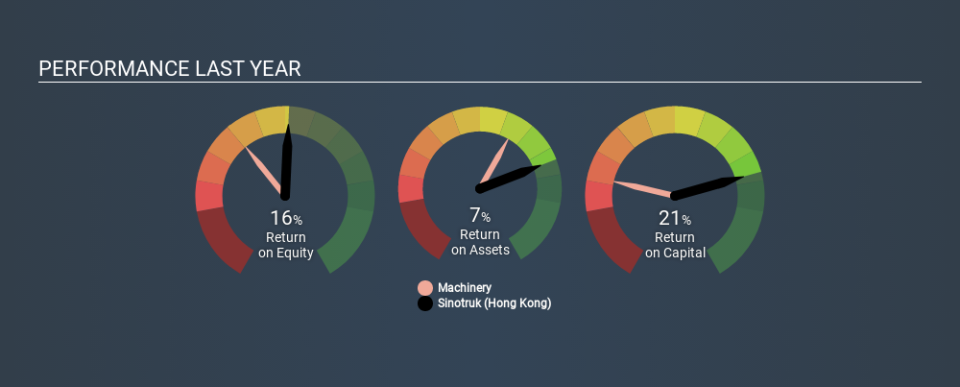Sinotruk (Hong Kong) Limited (HKG:3808) Earns Among The Best Returns In Its Industry

Today we'll look at Sinotruk (Hong Kong) Limited (HKG:3808) and reflect on its potential as an investment. To be precise, we'll consider its Return On Capital Employed (ROCE), as that will inform our view of the quality of the business.
Firstly, we'll go over how we calculate ROCE. Next, we'll compare it to others in its industry. Finally, we'll look at how its current liabilities affect its ROCE.
Understanding Return On Capital Employed (ROCE)
ROCE measures the 'return' (pre-tax profit) a company generates from capital employed in its business. Generally speaking a higher ROCE is better. Ultimately, it is a useful but imperfect metric. Author Edwin Whiting says to be careful when comparing the ROCE of different businesses, since 'No two businesses are exactly alike.
How Do You Calculate Return On Capital Employed?
Analysts use this formula to calculate return on capital employed:
Return on Capital Employed = Earnings Before Interest and Tax (EBIT) ÷ (Total Assets - Current Liabilities)
Or for Sinotruk (Hong Kong):
0.21 = CN¥6.2b ÷ (CN¥66b - CN¥37b) (Based on the trailing twelve months to June 2019.)
So, Sinotruk (Hong Kong) has an ROCE of 21%.
Check out our latest analysis for Sinotruk (Hong Kong)
Is Sinotruk (Hong Kong)'s ROCE Good?
When making comparisons between similar businesses, investors may find ROCE useful. In our analysis, Sinotruk (Hong Kong)'s ROCE is meaningfully higher than the 11% average in the Machinery industry. I think that's good to see, since it implies the company is better than other companies at making the most of its capital. Setting aside the comparison to its industry for a moment, Sinotruk (Hong Kong)'s ROCE in absolute terms currently looks quite high.
Our data shows that Sinotruk (Hong Kong) currently has an ROCE of 21%, compared to its ROCE of 2.8% 3 years ago. This makes us think about whether the company has been reinvesting shrewdly. You can click on the image below to see (in greater detail) how Sinotruk (Hong Kong)'s past growth compares to other companies.
It is important to remember that ROCE shows past performance, and is not necessarily predictive. Companies in cyclical industries can be difficult to understand using ROCE, as returns typically look high during boom times, and low during busts. This is because ROCE only looks at one year, instead of considering returns across a whole cycle. Since the future is so important for investors, you should check out our free report on analyst forecasts for Sinotruk (Hong Kong).
How Sinotruk (Hong Kong)'s Current Liabilities Impact Its ROCE
Liabilities, such as supplier bills and bank overdrafts, are referred to as current liabilities if they need to be paid within 12 months. The ROCE equation subtracts current liabilities from capital employed, so a company with a lot of current liabilities appears to have less capital employed, and a higher ROCE than otherwise. To counter this, investors can check if a company has high current liabilities relative to total assets.
Sinotruk (Hong Kong) has total assets of CN¥66b and current liabilities of CN¥37b. As a result, its current liabilities are equal to approximately 55% of its total assets. Sinotruk (Hong Kong)'s high level of current liabilities boost the ROCE - but its ROCE is still impressive.
What We Can Learn From Sinotruk (Hong Kong)'s ROCE
So to us, the company is potentially worth investigating further. There might be better investments than Sinotruk (Hong Kong) out there, but you will have to work hard to find them . These promising businesses with rapidly growing earnings might be right up your alley.
If you are like me, then you will not want to miss this free list of growing companies that insiders are buying.
If you spot an error that warrants correction, please contact the editor at editorial-team@simplywallst.com. This article by Simply Wall St is general in nature. It does not constitute a recommendation to buy or sell any stock, and does not take account of your objectives, or your financial situation. Simply Wall St has no position in the stocks mentioned.
We aim to bring you long-term focused research analysis driven by fundamental data. Note that our analysis may not factor in the latest price-sensitive company announcements or qualitative material. Thank you for reading.



